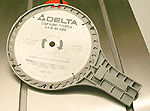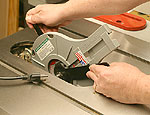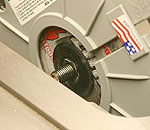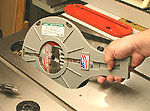This is a Veteran Owned site
![]()
The Saw-JawAn innovative idea that works!Text & Photos by Tom Hintz Changing and handling blades can be one of the better ways to wind up with nicks or cuts at the table saw. The Saw-Jaw, made in the U.S.A. by Hiqol L.C., (Cedar Falls, IA) is a new, thoughtfully designed tool that virtually eliminates these problems. The Saw-Jaw replaces jamming a piece of wood between an expensive blade and the saw's table when loosening or tightening the arbor nut, an accepted technique that I have never been a fan of. Initial Impressions The Saw-Jaw is injection molded using a heavy plastic that balances rigidity and flexibility appropriately for the task it is designed to do. The overall sizing is nice in that while it totally contains the blade, covering the cutting
not have to touch the blade itself during installation or removal! Design Features The Saw-Jaw is designed to wrap around a 10" blade. Its split handles make it easy to capture a blade whether it is installed or not. One side is almost totally open but covers the cutting edges completely. The other side has a 4 1/8"-diameter opening (closed around a blade) that provides easy access to the arbor nut and washer. Most blade stabilizers can also be removed or installed through this opening.
nut. Four tabs project from the outer rim (open side) inwards to keep the blade from falling out once the Saw-Jaw is locked around it. In the Shop
While the Saw-Jaw looked like a good idea from the first time I saw it, I became a true believer after using it in my shop. Add the Saw-Jaw to the short list of products that function at least as well as claimed.
The Saw-Jaw does fit but it's close. Once installed, the Saw-Jaw closes around the blade and that clearance problem goes away for removal or installation.
During the evaluation process, I unintentionally tested an unadvertised benefit of using the Saw-Jaw. While setting up for another photo, I accidentally knocked an expensive carbide-tipped blade off the saw. Fortunately, it was wrapped in the Saw-Jaw and despite landing on the concrete floor directly on its edge, suffered no damage. Without the Saw-Jaw, the blade would have certainly needed repair or replacement. ConclusionsThe Saw-Jaw is a well thought out tool that does everything its marketing claims - and more. With the Saw-Jaw, changing blades is a much less dangerous affair for you and the blade. This is another tool that makes so much sense I wonder why no one has thought of it before.
For me, just eliminating having to pry that piece of wood against the blade when loosening or tightening the arbor nut is worth the price. Do you have a comment about this page? - Email Me!
|
All written, photographic and drawn materials are property of and copyright by NewWoodworker.com LLC 2000-2019. Materials may not be used in any way without the written permission of the owner.






